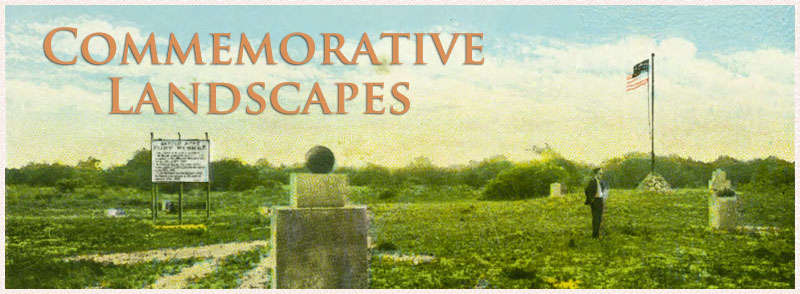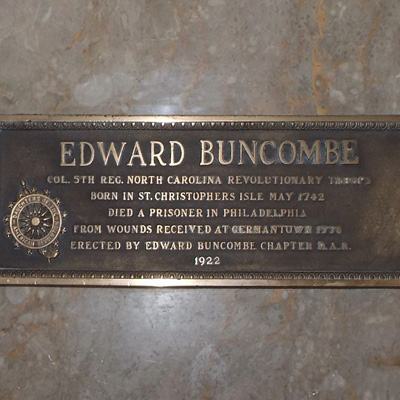
Edward Buncombe Plaque, Asheville
A simple bronze plaque about 12 inches high by 24 inches wide commemorates Edward Buncombe. It is attached to a wall between elevators in the lobby of the old section of the Buncombe County Courthouse. The plaque was originally attached to a large bolder outside of a previous court building. Above this plaque is another one of unknown origin saluting men who “Answered the Call to Colors.”
Images:
Far-off view of the plaque
EDWARD BUNCOMBE / COL. 5TH REG. NORTH CAROLINA REVOLUTIONARY TROOPS / BORN IN ST. CHRISTOPHERS ISLE MAY 1742 / DIED A PRISONER IN PHILADELPHIA / FROM WOUNDS RECEIVED AT GERMANTOWN 1778 / ERECTED BY EDWARD BUNCOMBE CHAPTER D.A.R. / 1922
Buncombe County
May 19, 1923
35.595980 , -82.548640
View in Geobrowse
"Buncombe County Court House, Asheville, N.C." in Durwood Barbour Collection of North Carolina Postcards (P077), North Carolina Collection Photographic Archives, Wilson Library, UNC-Chapel Hill. Link
"Buncombe County Court House, Asheville, N.C." in Durwood Barbour Collection of North Carolina Postcards (P077), North Carolina Collection Photographic Archives, Wilson Library, UNC-Chapel Hill. Link
McLemmon, Sarah Mcculloh. “Buncombe, Edward,” NCPedia.org, (accessed March 6, 2017) Link
“Edward Buncombe Chapter Issues Invitations for Unveiling of Marker,” Asheville Citizen-Times (Asheville, NC), May 15, 1923
“Memory of Buncombe Hero Will Be Honored,” Asheville Citizen-Times (Asheville, NC), January 29, 1930
“Monuments to Be Moved Soon,” Asheville Citizen-Times (Asheville, NC), February 12, 1929
“Unveil Marker in the Memory of Col. Buncombe,” Asheville Citizen-Times (Asheville, NC), May 20, 1923
Yes
Bronze
Edward Buncombe Chapter Daughters of the American Revolution
Edward Buncombe was a planter and officer in the Continental Line in the Revolutionary War. Born on St. Christopher (St. Kitts) island in the West Indies, he left there in about 1768 to make his permanent home in what was then Tyrrell County, on Albemarle Sound. Buncombe was elected colonel of the Tyrrell County militia on September 9, 1775 and transferred to the Fifth Regiment of North Carolina troops in the Continental Line on April 17, 1776. Severely wounded at the battle of Germantown he was left for dead but recognized by a former schoolmate in the British army. Still alive, he was moved to Philadelphia and granted a parole. A hoped for exchange with British prisoners was never accomplished and Buncombe was unable to return home. Without funds to pay for medical treatment Buncombe failed to make a complete recovery; in May 1778, while sleepwalking, he fell down a flight of stairs, reopened his wound, and bled to death. In 1791, Buncombe County was created in North Carolina and named for Edward Buncombe.
The plaque can be found in the lobby of the old 1927 section of the Buncombe County Courthouse, at College St. and Court Plaza, Asheville, NC. To access this lobby one must enter through the modern entrance facing College Street. On the same wall as Buncombe’s plaque is one to Lt. William Hardy. In the immediate area of the old Buncombe County Courthouse there are other notable plaques, monuments and memorials: Western North Carolina Veterans Memorial, 60th NC Regiment, Revolutionary War, Spanish American and other wars, Police and Firemen who died in the line of duty, Medal of Honor recipient Lt. Colonel Robert Morgan and former Governor Samuel Ashe for whom Asheville was named. Several hundred yards to the west stands the monument to Zebulon Vance and several other small markers.
The memorial plaque is in the lobby of the old historic section of the Buncombe County Courthouse.
The plaque was removed from a large bolder outside a courthouse building that was demolished after the 1927 courthouse opened. It was placed on the wall of the new courthouse in late 1929.
 Know anything else about this monument that isn't mentioned here? If you have additional information on
this or any other monument in our collection fill out the form at the Contact Us link in the footer. Thank you.
Know anything else about this monument that isn't mentioned here? If you have additional information on
this or any other monument in our collection fill out the form at the Contact Us link in the footer. Thank you.

